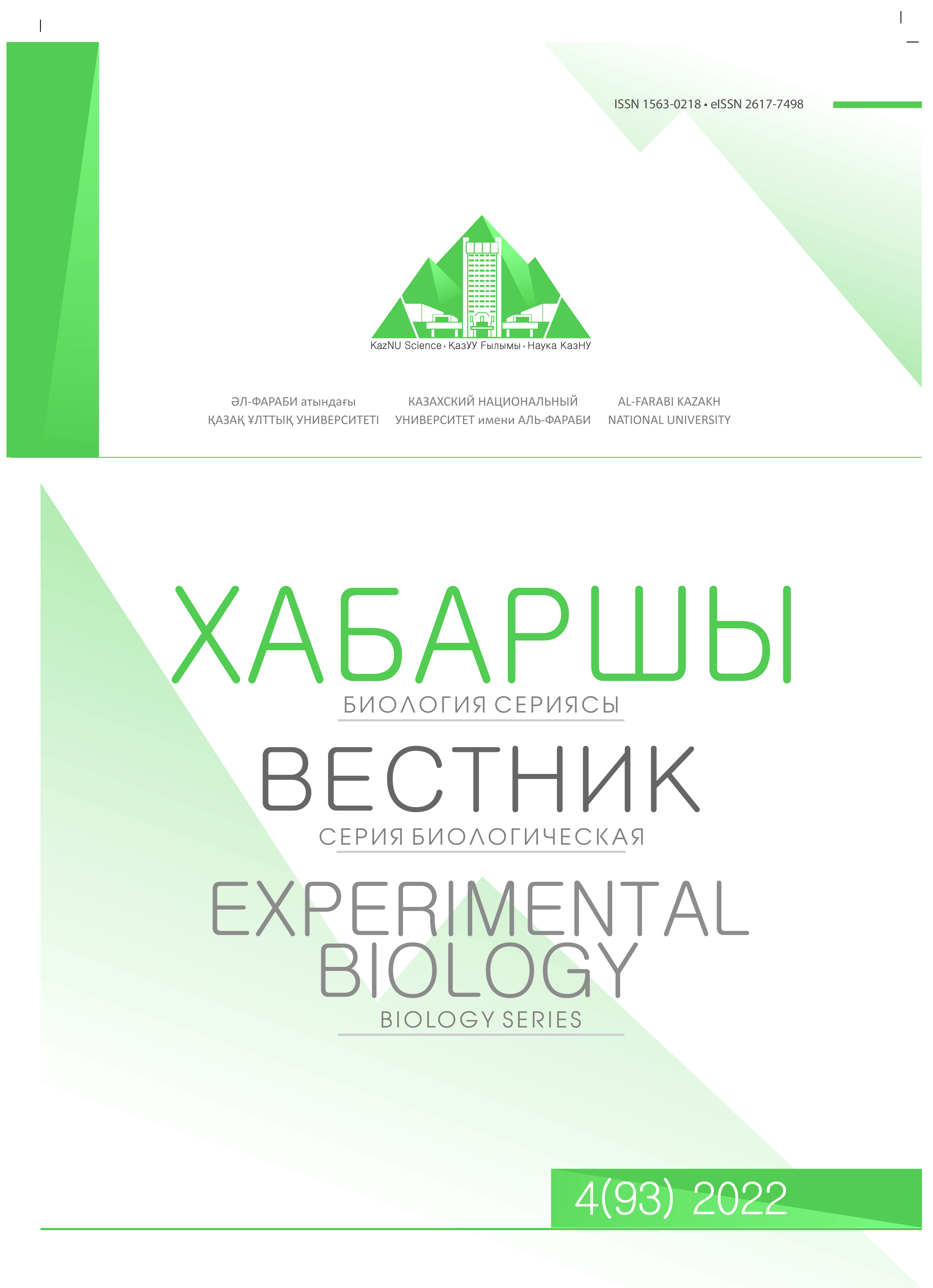NEW SPECIES OF MAMMALS IN KORGALZHYN STATE NATURE RESERVE
DOI:
https://doi.org/10.26577/eb.2022.v93.i4.014Abstract
Theriological studies of the Teniz - Korgalzhyn region are covered rather sparsely in the literature and are fragmentary, since the Korgalzhyn Reserve mainly has an ornithological direction. The purpose of this article is to study the current state of the species composition of mammals of the Teniz-Korgalzhyn region and make the necessary additions to it. The research work was carried out for the period from 2016-2021. The authors of the article, based on the actual research conducted on the inventory of mammalian species in the reserve, prove the presence of local populations of species not previously noted on the territory of the reserve and include them in the inventory list of the theriofauna of the reserve. The material was collected on the territory of the Korgalzhyn State Nature Reserve and in its surroundings. Literary and intradepartmental data were also used. To include a new species in the list of local theriofauna and to distinguish individual visits of animals from the formation of a local population in the study area, 2 criteria were used: frequency and geography of encounters, and breeding of offspring. Of the 4 species new to the region, 2 species are native to Kazakhstan (Siberian roe deer, yellow gopher). Their presence in the region is insignificant and probably does not have a negative impact on the existing ecosystem of the region. The greatest concerns are caused by 2 acclimatizant species, namely the American mink, raccoon dog. Which are recognized as invasive species in Russia and Kazakhstan. The possibilities of the distribution and reproduction of these species in the territory they have developed and the possible impact on the native fauna of the region are also analyzed.
References
Atlas vodno-bolotnyh ugodij Kazahstana (demonstraciya na trekh global'no znachimyh vodno-bolotnyh ugod'yah). Astana 2009 pp. 44
Bobrov V.V., Varshavskij A.A., Hlyap L.A. CHuzherodnye vidy mlekopitayushchih v ekosistemah Rossii Moskva 2008. pp. 220
Danilkin A. Behavioural ecology of Siberian and European roe deer. L.: Chapman & Hall, 1996. pp. 277.
Engeman R.M., Allenllen L. Overview of a passive tracking index for monitoring wild canids and associated species. Integr.Pest Manag. Rev.- 2000.-5, №3 -pp. 197-203.
Global'no znachimye vodno-bolotnye ugod'ya Kazahstana. Teniz-Korgalzhynskaya sistema ozer. Tom 2. Astana. 2007. pp. 231-232
Grachev YU.A. Pozvonochnye zhivotnye Kazahstana. Klass Mammalia. Almaty. 2013 pp. 219 -255
Karpenko N.T. Raccoon - like dog as introdutcentny view fauna in the reserve of ''Bogdinsko - Baskunchaksky''// Astrakhan Bulletin of Environmental Education 2012. N 3 (21). - pp. 140-143.
Kazenas V.L. Zhivotnye Korgalzhynskogo zapovednika. Almaty, 2013. pp. 41
Koshkin A.V. Fauna Korgalzhynskogo zapovednika. Razdel - Mlekopitayushchie. Astana. 2007. pp. 46-51
Krivoshapkin A.A., Kirillin E.V. CHislennost' sibirskoj kosuli (Capreolus pygargus pal.) v central'noj JAkutii i faktory, opredeljajushhie ee dinamiku // Vestnik JAGU, 2006, tom 3, №2, - S.5-10
Letopis' prirody Korgalzhynskogo gosudarstvennogo prirodnogo zapovednika za 1974-2021 gody.
«Metodicheskie rekomendacii po vedeniyu monitoringa komponentov bioraznoobraziya v Korgalzhynskom zapovednike, kak osnovy dlya ustojchivogo upravleniya OOPT» Astana 2010. – S. 50.
«Metody ucheta osnovnyh ohotnich'e-promyslovyh i redkih vidov zhivotnyh Kazahstana» Almaty. 2003.pp.19-33.
Michener G. R., 1979. The circannual cycle of richardson's ground squirrels in SouthernAlberta // J. Mammal. Vol. 60. pp. 760—768.
Mlekopitayushchie Kazahstana. V 4-h tom 3 chast' 2. Alma-Ata: «Nauka» KazSSR. pp. 88.
Mlekopitayushchie Kazahstana. V 4-h tom 3 chast' 1. Alma-Ata: «Nauka» KazSSR. 1981, pp. 133-137
Palason S., Ceña C.J., Mañas S., Ceña A., Ruiz-Olmo J. Current distribution and status of the European mink (Mustela lutreola L., 1761) in Spain // Small Carnivore conservation. Newsletter and Journal of the IUCN/SSC Mustelid, Viverrid & Procyonid Specialist Group. 2002. N 26. pp. 9–11.
Sidorovich, V. E. The change in the food niche of the European and American mink during the invasion of the American mink in the north-east of Belarus [Text] / V. E. Sidorovich, A. G. Polozov, A. Zalevsky // Biological invasions. - 2010. - Vol. 12, No. 7. - pp. 2207-2217
Sidorovich V.E., Macdonald D.W. Density dynamics and changes in habitat use by the European mink and other native mustelids in connection with the American mink expansion in Belarus // Netherlands J. Zool. 2001. Vol. 51. pp. 107–126.
Smal, C.M. Feral American mink in Ireland / C.M. Small // Occ. Publication. 1991. Wildlife Service. 51 St. Stephen's Green. Dublin 2. The Office of Public Works.
Smith A., Schaefer J.A. Home-range size and habitat selection by American marten (Martes Americana) in Labrador. Can. J. Zool.- 2002.- 80. № 9. - pp. 1602-1609.
Taxonomic and Geographic Reference (3rd ed.). Johns Hopkins University Press. pp. 532—628.
Trapezov, O. V. Effect of Behavior on the Expression of Coat Colour Mutations in American Mink. Proceedings from the Vllth International Scientific Congress in Fur Animal Production. Volume III: Contributed papers. B: Genetics. pp. 127-133. September 13-15, 2000, Kastoria, Macedonia, Greece.
The IUCN Red List of Threatened Species.Version 2016-3. Mustela lutreola (European mink) //http: //www.iucnredlist. org.
Wozencraft, W. C. (2005). «Order Carnivora». In Wilson, D. E.; Reeder, D. M. (eds.). Mammal Species of the World: A
Zveri Kazahstana. Akademiya nauk KazSSR. Alma-Ata, 1953. pp. 417-420




